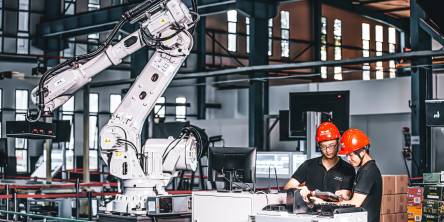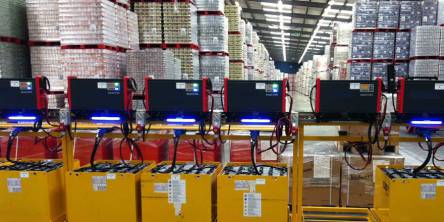Effects of Furnace Slip on the Wafer Strength
The silicon wafers are strong at room temperature, but they become weaker as the temperature is increased. The furnace manufacturing steps are essential for the processing of IC’s (integrated circuits). During this process, a non-uniform high temperature produces a non-uniform expansion within the wafer. Therefore, a consequential thermal stress can cause restricted or extensive furnace slip.
It obstructs the formation of silicon crystalline structure and completely decomposes the electrical and physical features of the wafer. The dislocations that are formed by slip can cause gate oxide integrity collapse, severe junction leakage, and untimely breakdown. The physical deformation can cause wafer breakage, pattern misalignment, chucking problems, and focus instability.
A non-uniform temperature is produced in the silicon wafer during temperature furnace push. This causes a bright beaming energy from the kiln tube to heat up the wafer edge prior than the wafer center. This can also cause slip around the silicon wafer edge and the deformation of the silicon wafer. During temperature ramp-down and furnace pull, the wafer cools earlier at the edges than in the center. This causes temperature non-uniformity at the wafer center and causes the wafer to bend.
After years of experience in fabrication of ICs (on silicon wafers), engineers revealed that furnace slip has always created a problem. The engineers have always faced problems in increasing the speed of furnace, temperature ramps and push-pull to maximize the furnace output. However, at the same it is also necessary to restrain the speed of temperature ramps and push-pull to prevent wafer damage. Whenever a new IC technology produces extreme built-in device stress, the balance shifts. This is because furnace recipes which had earlier created slip-free silicon wafers became recipes that created massive furnace slip.
In the thermal cycling process, the stress which occurs on oxide is used on the trench of sidewalls. The thermal stress created due to temperature non-uniformities in the wafer generate slip dislocations and shift those dislocations into the leakage sensitive area of the device. Now days IC devices with STI structures can be fabricated easily by moderating both the furnace stress and the built-in IC device stress.
Temperature is the most important factor that controls the strength of the thermal oxide silicon wafers, and this must be kept in mind when setting temperature ramping and furnace pull/push conditions. The strength of the wafer decreases drastically when the temperature is increased from 700°C to 800°C. If wafers are pulled or pushed into a furnace with the tube set at 800°C, the slip creates problem and can damage it. Therefore, the strength of the wafer is inversely proportional to the increase in temperature. It is essential to use lower ramping rates for higher temperature ranges to prevent wafer slip during furnace temperature ramping.
Other factors that affect the strength of the silicon wafer:
- The higher the density of dislocations in a thermal oxide silicon wafer, the weaker the wafer. It takes a large stress to create a dislocation, but only a small stress can cause an existing dislocation to multiply or move.
- The higher the interstitial oxygen concentration, the stronger the wafer. Dissolved or interstitial oxygen atoms connect themselves with dislocations and stop them from multiplying.
- The higher the amount of precipitated oxygen, the weaker the wafer. Increasing oxygen precipitates use up the interstitial oxygen and blow out the new dislocations.
- The higher the concentration of dopant atoms, the stronger the silicon wafers. The damaged fields around atoms, which are larger or smaller than the silicon atoms, obstruct the motion of dislocations.
- Integrated circuit films can apply stress on the underlying silicon wafers and make slip more appropriate. Trench and other IC structures, as well as mechanical damage issues, can deteriorate the wafer by acting as stress concentrators.
Similar Articles
When comparing flow control solutions, you may encounter the decision between manual butterfly valves and ball valves. Both types offer distinct advantages and play critical roles in various applications.
Many companies love Lean Manufacturing because it makes things better. It boosts productivity, makes quality top-notch, and saves money while speeding up production. Lean Manufacturing isn't a strict set of rules; think of it as an intelligent way of thinking. It's all about cutting out unnecessary stuff (the "8 wastes") and focusing on what customers want.
Whether you’re a business owner, a supplier, a client, or just an admirer of the oil industry, there’s one thing you have to admit - this industry is among the most interesting ones in the world, and it’s getting more and more interesting every single year
Although the terms "laser engraver" and "laser cutter" are often used in the same context, there are a few differences between them. People have a huge misconception regarding the functions of both terms. In the present world scenario, laser machines can cut as well as engrave single-handedly.
The manufacturing industry, much like a lot of other industries worldwide, has been subjected to a whole lot of changes over the past few years. The cause? Lots of them but primarily the rapid evolution of technology.
The metal industry implies a diverse range of processes, skills and tools to manufacture parts, objects and even large scale structures. With the emergence of modern metalworking tools, a product receives a high level of uniformity and specificity.
In this modern world, all new types of technologies are invented for the benefit of human beings. There are many new things that are used in both commercial and military purposes, and one of the examples is aerospace fasteners. The use of this technology has increased with the invention of the fasteners.
The concept of automating a warehouse has been in place for several years. There is an increased demand for an automated warehouse in recent years due to various reasons. The costs of land and labor have gone up, companies are handling huge deliveries, and consumer expectations are high.
To stay competitive in today’s world, you need to develop technologies that cause less environmental damage. Leading forklift charger manufacturers are then launching a larger number of environmentally-friendly trucks that provide the same efficiency to fulfill their customer’s requirements.







6b16.jpg)

